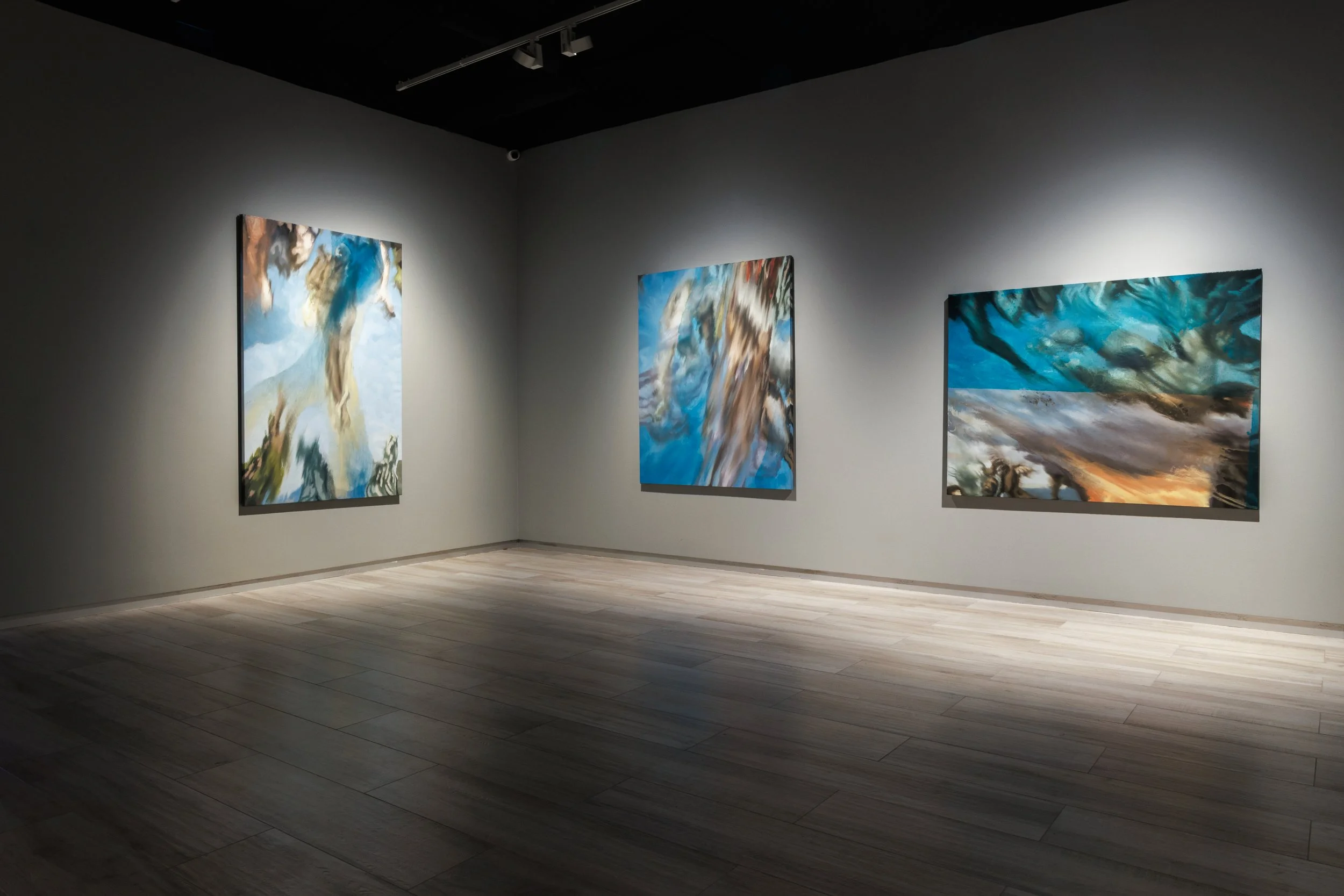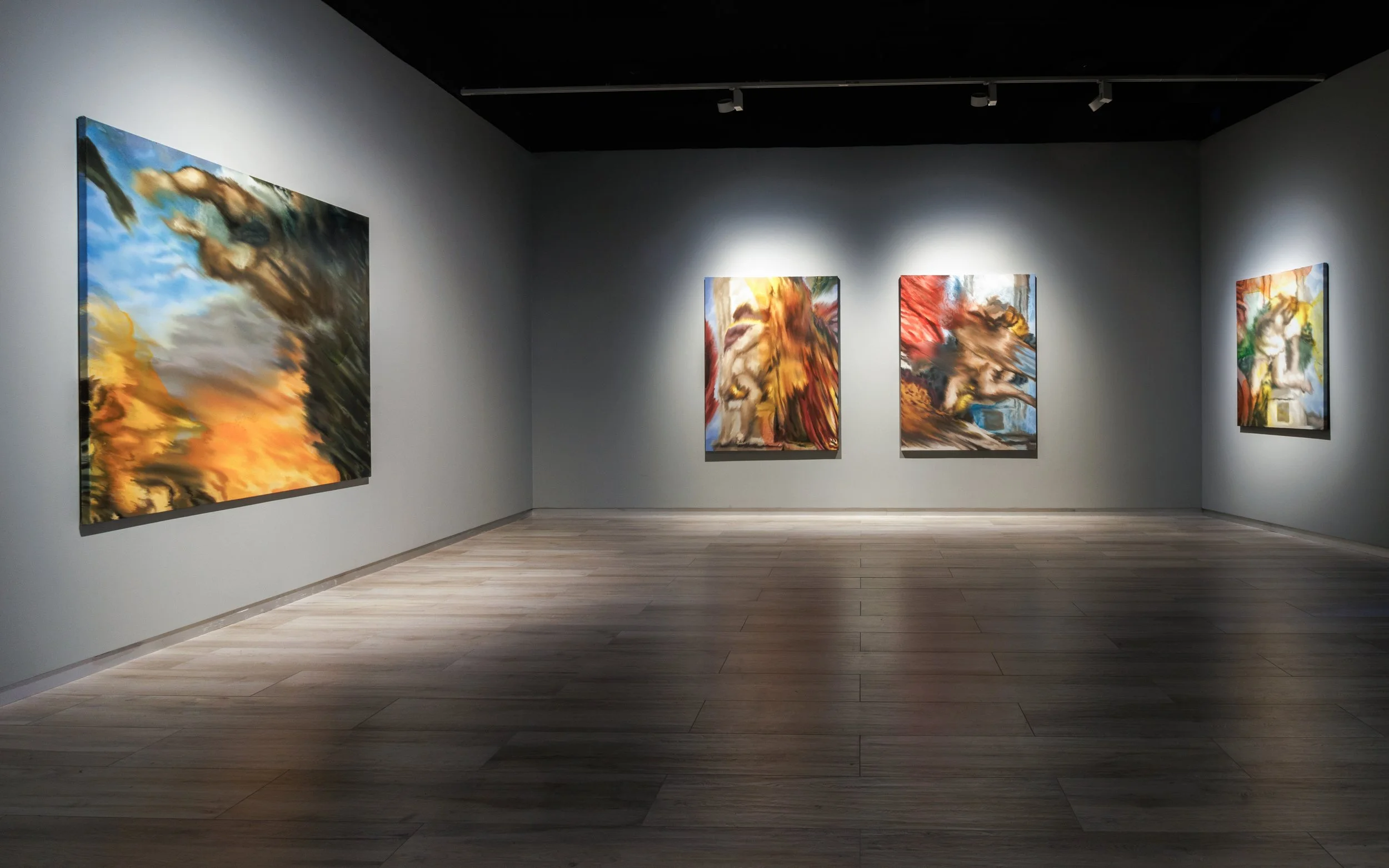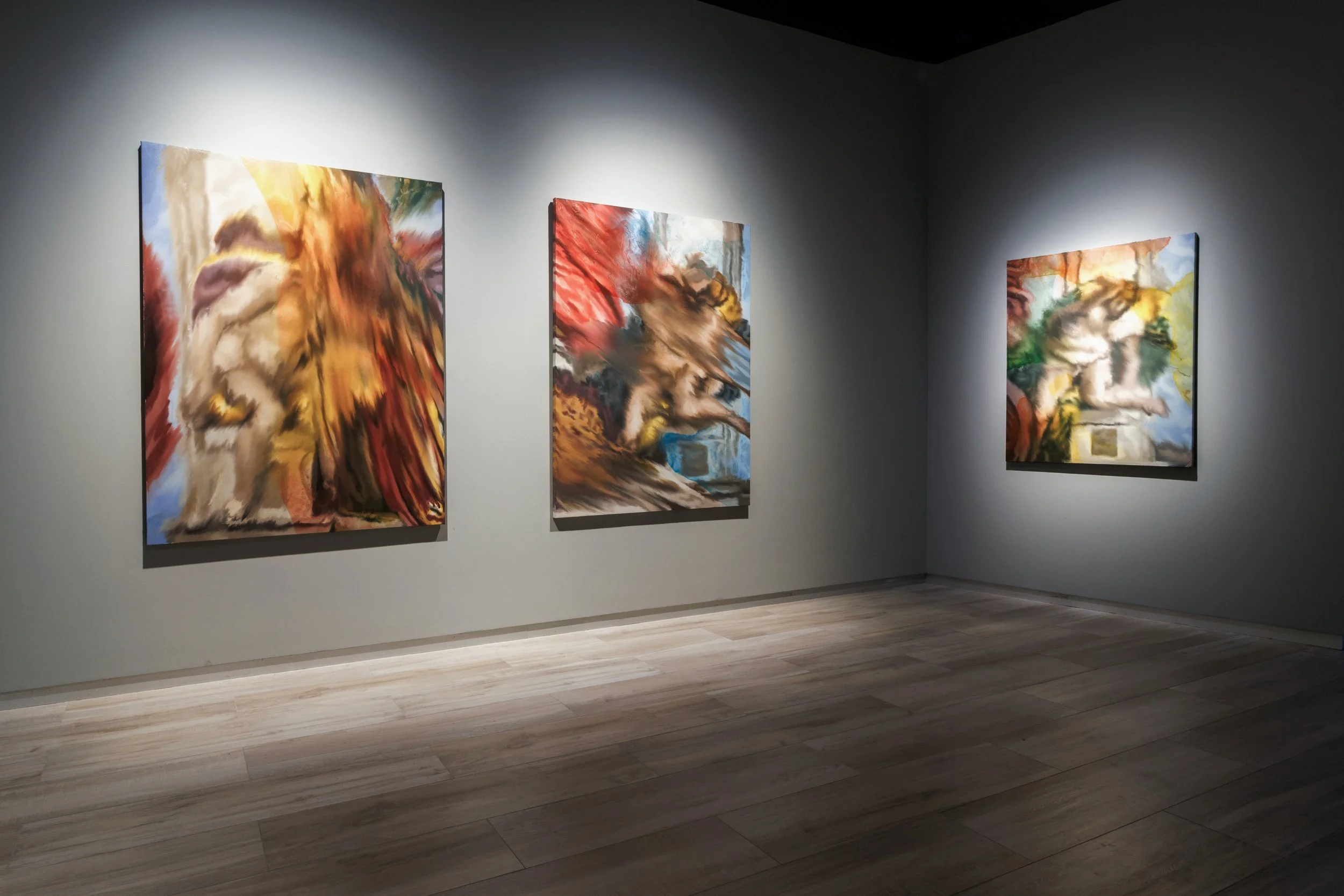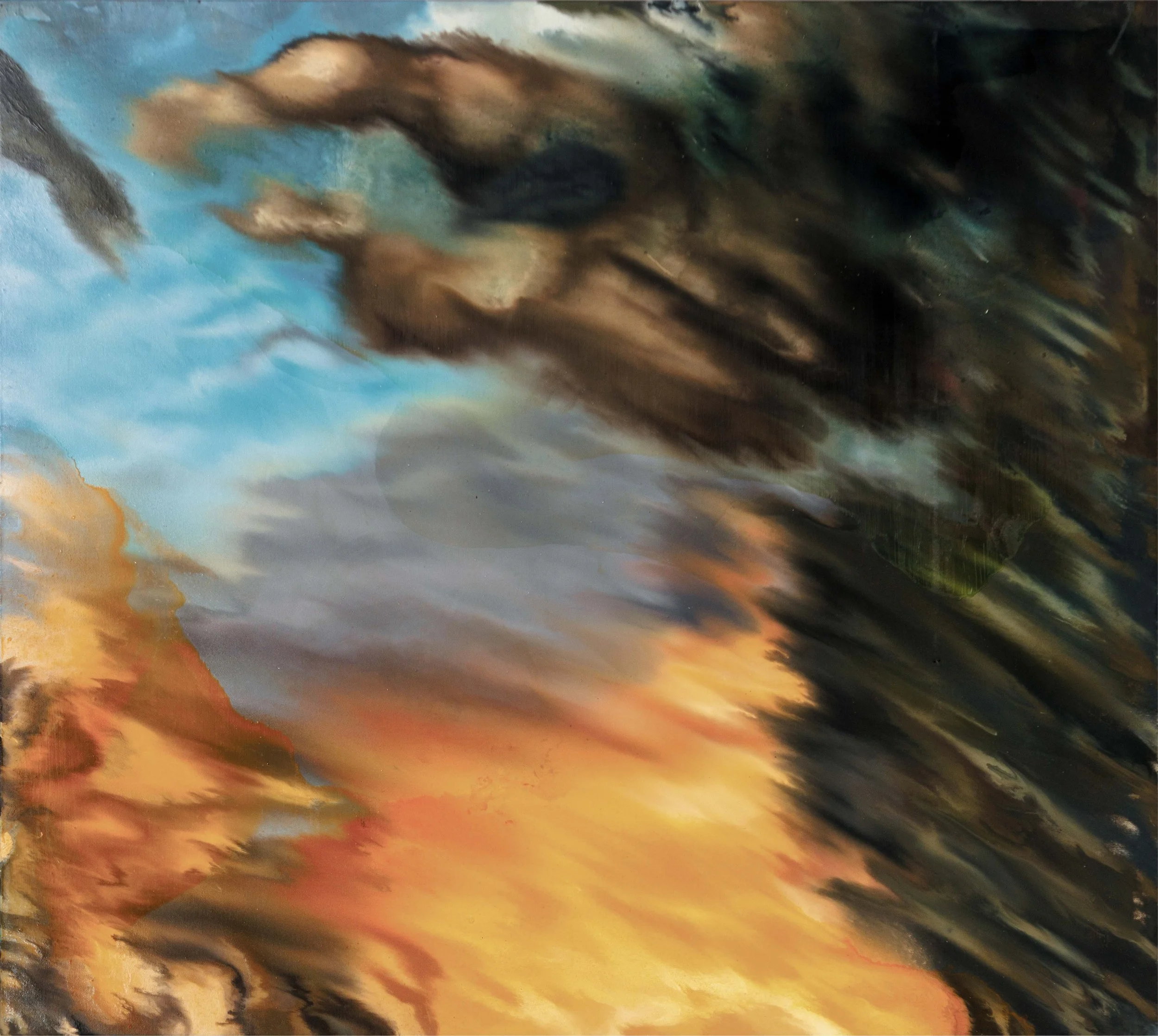LIGHT BEYOND THE OBJECT:
Variations of Michelangelo
Jorge R. Pombo
May 25th - June 27th 2024
There is a school of thought that speaks about great art, which simultaneously pulls from the past, exists firmly in the present, and reaches toward the future. Jorge R. Pombo’s (Pombo) one hundred and eighty square-meter piece, a reimagined depiction (or reinterpretation) of Michelangelo’s 16th-century Sistine Chapel altar fresco, The Last Judgment, certainly conforms to this criterion of not only having the ability to transcend temporal boundaries but also serves as a profound exploration of the "struggle of opposites," one of the interlocking themes throughout his body of work. This focus manifests in the juxtaposition of abstraction and figuration, where viewers are presented with images that oscillate between discernible forms and obscured details through a process of creation and destruction. His visual repertoire is inspired by enduring works by Caravaggio, Velázquez, Gericault, Delacroix, Titian, and Tintoretto, juxtaposed with the conceptual rigor of Mondrian, Richter, Polke, and Gilliam amongst others. Hence, his unique approach fosters tension within the artwork, encapsulating the conflict between historical fidelity and contemporary reinterpretation without resolving these elements into a harmonious synthesis.
Michelangelo’s The Last Judgment is a masterpiece of the Renaissance era and a cultural artifact imbued with detailed iconography and layers of theological significance. In choosing this iconic piece as a foundation for his exploration, Pombo taps into its legacy and injects it with modern sensibilities. His technique—applying and then removing layers of paint with poured oil solvents to dissolve and strip down the layers of his paintings partially—also metaphorically represents spiritual and artistic transformation, the struggle between creation and destruction, presence and absence. This technique highlights a schism between what is permanent and what is transient, between the artist's control and the inherent unpredictability and randomness of material and process akin to the action moves of Jackson Pollock.
Pombo is acutely aware of the relevance of Dies Irae—Latin for day of wrath—which in contemporary times extends far beyond its original liturgical context as a hymn describing The Last Judgment, where God judges all souls during a day of reckoning (and eventual renewal). He states, “For us actors in the world of the 21st century, The Last Judgment is no longer an event that awaits us, it is rather an incessant daily review of our every action.” Thus, using solvents physically alters the paintings and symbolically represents a deeper philosophical and existential exploration of life, death, and rebirth. Boundaries between the old and the new are blurred. This method creates a dynamic interaction between what is immediately visible and what lies beneath. Pombo notes, “Standing in front of these paintings, one may recognize elements of the original masterpiece intertwined with bold, abstract gestures that disrupt the narrative and invite alternative interpretations.” He is cognizant of the weight of responsibility for his creation; freeing historical classical art from its dense narrative content represents a form of immense courage and liberation. He strips away the layers of historical and theological storytelling imbued in The Last Judgment, focusing instead on the elemental, but still emotional aspects of painting: color, form, and texture. Creating The Last Judgment in 2024 based on past paradigms would widen the gap with the “other,” so he enlisted individuals with intricate life journeys, including periods of homelessness and firsthand experience of life's darker aspects, to bring a more inclusive perspective to his work. From the first moment Pombo imagined The Last Judgment, he felt that if it were painted by individuals with extensive experience in the “human condition”—those who had felt loneliness, lack of solidarity, and even the generosity of voluntary aid—this symbolic gesture would give the project a much broader and more profound meaning.
This process does not erase the original meanings of the works but rather recontextualizes them, inviting contemporary audiences to engage with the art from a fresh perspective, free from the predefined interpretations of the past. He is intentional about leaving behind “what separates the cultures and identities”, and instead emphasizes unity amidst diversity. This collaborative approach mirrors the globalized context of modern art, compiling a production team with varied beliefs—from Christianity to Islam, Hinduism to atheism, and new age philosophies. This diversity enriches the artistic process, ensuring the artworks resonate on multiple levels, and fostering connections that transcend specific religious or cultural identities.
Historically, The Last Judgment has inspired myriad artistic interpretations, engaging theologians, musicians, writers, and artists across different eras. Originating in the Middle Ages, these representations celebrated individual salvation and eternal life. Among these, Pombo's work stands out for its profound exploration of art's capacity to convey timeless themes deploying a contemporary filter. Against the backdrop of the Protestant Reformation and Catholic Counter-Reformation, Pombo's art reveals a deep understanding of how art can attempt to transcend time and convey universal truths. This exhibition, The Light Beyond The Object, presents a nuanced vision of art's potential to convey enduring themes using contemporary practices and perspectives. Through his incorporation of modern insights, Pombo bridges the gap between past and present, challenging viewers to reconsider traditional narratives within a modern context.
-Michael Edwards
Ascensione Dell’anima (1), Variazione di Michelangelo, 2023 Oil on linen 78.75" x 51.125" 200 x 129.9 cm
Variazione del Giudizio Universale di Michelangelo Buonarroti (11), 2020 Oil on linen 67.125" x 74.875" 170.5 x 190.2 cm
Variazione del Giudizio Universale di Michelangelo Buonarroti (18), 2022 Oil on linen 67" x 55.25 170.2 x 140.3 cm
Variazione della Volta della Cappella Sistina di Michelangelo (14), 2021 Oil on linen 67.25" x 51.125" 170.8 x 129.9 cm
Variazione della Volta della Cappella Sistina di Michelangelo (15), 2021 Oil on linen 67.25" x 51.125" 170.8 x 129.9 cm
Variazione del Giudizio Universale di Michelangelo Buonarroti (10), 2022 Oil on linen 51.25" x 67" 129.9 x 170.2 cm
Variazione della Volta della Cappella Sistina di Michelangelo (8), 2021 Oil on linen 51.125" x 39.375" 129.9 x 140.3 cm
Variazione della Volta della Cappella Sistina di Michelangelo (26), 2021 Oil on linen 28.875" x 23.75" 73.3 x 60.3 cm













